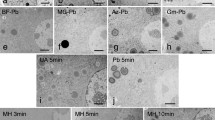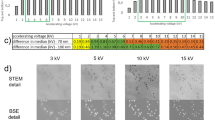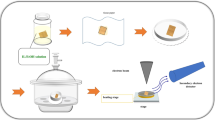Abstract
SOLUTIONS of lead are now widely used by some electron microscopists for the production of a general increase in the electron density of cellular constituents in sections of biological material fixed in osmium tetroxide and afterwards embedded in methacrylate or ‘Araldite’. Grids bearing the sectioned specimens may be floated face downwards for a few minutes on the surface of weakly ionized lead solutions, for example, lead acetate or ‘alkaline’ lead hydroxide1. During this exposure lead ions become attached to the osmium already deposited on the material during fixation, with a consequent improvement of specimen contrast in the electron beam.
This is a preview of subscription content, access via your institution
Access options
Subscribe to this journal
Receive 51 print issues and online access
$199.00 per year
only $3.90 per issue
Buy this article
- Purchase on Springer Link
- Instant access to full article PDF
Prices may be subject to local taxes which are calculated during checkout
Similar content being viewed by others
References
Watson, M. L., J. Biophys. Biochem. Cytol., 4, 727 (1958).
Peachey, L. D., J. Biophys. Biochem. Cytol., 5, 511 (1959).
Author information
Authors and Affiliations
Rights and permissions
About this article
Cite this article
LEVER, J. A Method of staining Sectioned Tissues with Lead for Electron Microscopy. Nature 186, 810–811 (1960). https://doi.org/10.1038/186810a0
Issue Date:
DOI: https://doi.org/10.1038/186810a0
This article is cited by
Comments
By submitting a comment you agree to abide by our Terms and Community Guidelines. If you find something abusive or that does not comply with our terms or guidelines please flag it as inappropriate.



